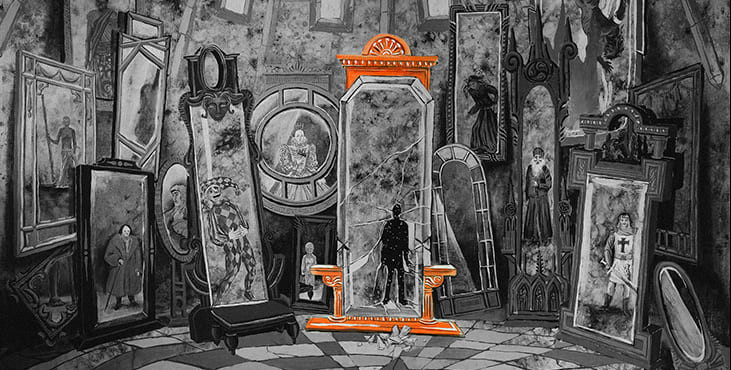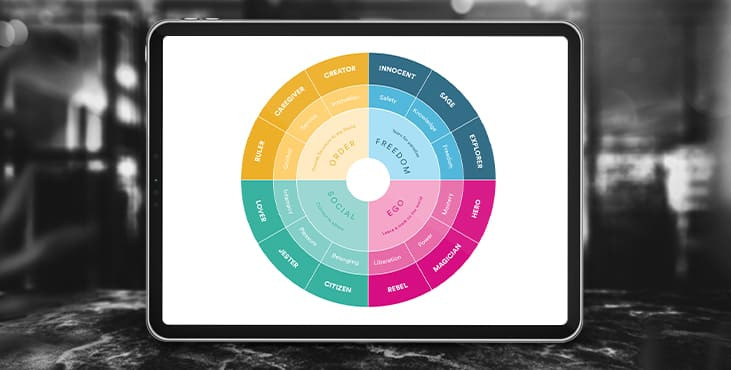
What are archetypes in branding?
Archetypes in branding are used to guide and reinforce a brand's story. Choosing an archetype can help your brand establish meaningful relationships with current and future customers. It's also a great way to stand out in a busy market and make a lasting impression on potential buyers.
I think about it. What do Simba the lion, Frodo Baggins and Braveheart have in common? They are all heroes, fighting valiantly for the greater good, usually at their own expense. The hero is just one type of archetype used in literature, movies, and TV shows. Archetypes are an important part of storytelling because they evoke emotion and create personal connections between characters and their audience.
Here's what you need to know about brand archetypes and how to choose one for your business.

What are brand archetypes?
Archetypes are usually associated with characters in stories. However, they often involve themes and emotions that go far beyond the script. According to Archetypes in Branding, "archetypes are patterns of ideas and ways of thinking that are consistent across time, generations, and cultures." Archetypes remain the same over time because they represent the values, traits, and motivations inherent in human nature.
For example, people are constantly inspired by heroes. Heroes personify the courage that lives in each of us. Brands like Nike, who embody the hero archetype, inspire us to become the strongest and bravest versions of ourselves. Nike shoe styles may change over time. But heroes always make people feel strong and motivated, no matter what year it is.
The hero is just one of the twelve main archetypes that guide modern brands. These twelve characters were first described in a famous book called The Hero and the Outlaw, published in 2001 by Carol S. Pearson and Margaret Mark. This book explores how archetypal stories can be used to create a strong identity both inside and out. He also warns against the misuse of archetypes, explaining where and how each character can survive the fall.
Why do archetypes matter?
As we discussed above, archetypes are associated with universal human desires. They take sales pitches and value propositions and turn them into personas that people can understand. This all sounds warm and vague, but by now you're probably wondering: how do archetypes relate to business goals?
We don't blame you for asking. To understand why brand archetypes matter to your bottom line, consider three benefits of archetypal branding:
Archetypes Support Differentiation
Not sure how to stand out from the crowd in a saturated market? The answer may be a strong archetype. Archetypes inspire you to delve into the roots of your brand and find the reasons behind everything you do. The people, places, and ideas that shaped the beginning of your brand are truly unique to your brand. This is especially important to remember when you share the same archetype as another brand in your industry.
If you're struggling to stand out, remember the DNA that makes your brand a rare gem.
Archetypes set the tone for brand experiences
Archetypes form the basis for customer experiences and relationships. For example, a brand with a carer archetype will exude a helpful, personable, and supportive personality. Once these characteristics are established, the person will form expectations for the next brand experience. I hope the brand lives up to these expectations. When this happens, the client learns to trust you and what you have to offer. Repeated and consistent experience is the foundation of a loyal customer base.
Archetypes reflect the desires of customers
The power of archetypes is that they can be tailored specifically to the needs and desires of your audience. Whether it's creativity, motivation, or innovation they crave, there's an archetype for it. In other words, brands use archetypes to connect the needs of the audience with your product. This helps them understand why your product can help you achieve your personal goals, leading to stronger and more authentic relationships with consumers.
Choosing your brand archetype
Finding the right archetype for your brand is critical to creating a recognizable, consistent, and unique identity. After learning more about the twelve most common archetypes, consider which ones fit your brand.
Hero
We discussed how a brand hero can make customers feel empowered, and motivated. In addition, the hero archetype also contributes to positive changes in the world. To be a hero, a brand must encourage its followers to maintain self-discipline and overcome adversity. However, be careful not to come across as too selfish or aloof.
Magician
Secret. Potential. Transformation. These traits are embodied in the magician archetype, who is known for his intuition and charisma. The magician archetype is less common than the creator, but has a similar sense of ingenuity and creativity. Magician brands include Disney, AX TED and XBOX. The key is to be imaginative, but be sure to maintain a sense of realism and attainability.
Outlaw
Outlaw is a cool and charming archetype of the Rebel character archetype. Whether it's profanity on social media or posting risqué ads, the perpetrator doesn't adhere to social norms. In fact, he lives for shock and awe. Harley Davidson, Oskar Blues Brewing, Nasty Gal and Virgin are all examples of brands that go against the status quo. Being a criminal is a great trait. Chances are you'll offend someone with this archetype just make sure it's not your target audience that feels the burn.
Researcher
Explorer brands are outgoing, adventurous and daring. Companies like Patagonia, REI and Topo Designs are great examples of research brands. Not only adventurous in their products and mission, but also inspire customers to discover new paths and overcome the unknown. Invite clients to join you on your journey, but give them support so they don't feel excluded along the way.
Sage
A sage is like a reliable and intelligent friend who can always be relied upon. Google and The Wall Street Journal are examples of smart brands that people turn to for information. Oprah, Marie Forleo, and the Dear Sugars podcast are characters who also embody such traits, albeit on a journey of personal growth and self-improvement. Hence, these characters share a common goal: to understand the world by sharing knowledge along the way. Don't try to sound too smart, as this can make your clients feel inferior.
Innocent
Innocent brands are simple, carefree and happy. Hence, this is the kind of character people can turn to when they need a refreshing, transparent and positive boost. However, they do have a number of caveats that people can rely on. Brands in the sustainability, health, and food categories are often harmless. Think seventh generation, Dove, The Honest Company and Warby Parker. Innocent brands sometimes lack a foundation, so make sure you define your values and stand by them.
Creator
As you probably guessed from the name, the creator archetype is artistic. The creative archetype, also known as the builder, is about discovery and innovation. Lego is a brand known for its creator archetype. Lego aims to reimagine human capabilities through imaginative play that expands a child's potential. The Creator exalts everything artistic, but at the same time maintains a commitment to truth and integrity.
Ruler
Like a king or leader, a ruler is an archetype who paves the way for others. More often than not, line brands focus on creating exclusivity and class. This is why leading brands often create luxury items like Mercedes or Rolex. The ruler archetype can be a powerful way to build a cult of followers and create a sense of lack. However, brands should beware that the line may look pompous and too exclusive.
Caregiver
The caring archetype is exactly what it sounds like: nurturing, helpful, and altruistic. The caretaker sometimes goes hand in hand with the hero archetype as they share a common passion to make the world a better place. Caregiver brands include TOMS, Johnson & Johnson, and St. Jude's Hospital. When you court, this is the key to showing that you are strong and capable.
Everyman
We are all familiar with the term "girl/boy next door". This is exactly the character that the layman dreams of. Modest and accessible, each person puts quality over quantity. This archetype is not aimed at a quick sale. Rather, they would rather sit down, open a beer and talk a little about life. The best examples of conventional brands are Levi's, IKEA and Budweiser. Each person is supposed to be versatile, but they still need to find their target audience so that the messages are targeted and specific.
Jester
Everyone loves a classy clown. The jester follows suit, seeking to spread joy through humor and mirth. The key to successfully promoting a jester brand is entertainment. Dollar Shave Club is a great contemporary example of how humorous videos can help build brand awareness by making people laugh. Jesters can sometimes go too far, so brands need to make sure that humor remains sensitive and within reason.
Lover
Proximity is a basic human need. Lover seeks to satisfy this need by sharing products and services that bring people closer together. Treats such as Dove chocolate or Barefoot wine fall into this category. Victoria's Secret and Cosmopolitan Magazine are other popular examples of love brands. One of the downsides of lovers is that they can sometimes be seen as too selfless and out of touch with human nature, which can make it difficult for them to communicate.
Discovering your brand archetype will reinforce and channel your brand personality to attract your ideal customer base.
Get a creative brand asset as a bonus
Tell us what you think
By clicking 'Submit', you agree to Privacy Policy and authorise our staff to contact you. You are liable under the Personal Data Protection Act if you key in false personal data or other people’s personal data.
offers and news
